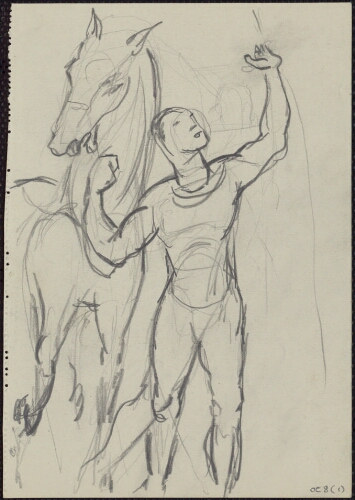By Pierre Ayel and Sylvie

Croquis d’homme tenant un cheval
Serge Choubine (1900-1931)
Dear readers,
Have you recently seen, in the Théâtre de la cité, the new show of the circus company Baro d’Evel? If you saw it, you may have been, like me, surprised by the apparition of a horse on the stage. But, after having read this article, you will see that horses and circus have been linked since the end of the eighteenth century.
At that time in England, the royal law, with the 1737 Licensing Act, allowed only three venues to perform “legitimate theater”. So, these royal venues and the king’s theater companies who had the license had a monopoly on real drama, which was spoken theater. All the others had only the possibility to perform “public dancing and music” and “other public entrainements of the like kind”.
To pass off the prohibition and perform real drama, one man, Philip Astley, an equestrian, following the success of trick-riding displays, started to organize equestrian shows. He adapted common stories and plays in a way where trained horses performed the leading roles of a drama, carrying out the plot. The first show on the legitimate stage of London was performed in February 1811. Hippodrama was born. This new kind of pantomime had a great international success: Astley had his own circus in London, as did some of his rivals, and cities around the world like New-York, Philadelphia, Sydney or St Petersburg.
During this creative and successful period for hippodrama, some other equestrians became famous. One of them, Andrew Ducrow named “the colossus of equestrian performers” created an equestrian performance which became so famous that it’s still performed today. This performance named ‘The Courier of St.Petersburg” tells the story of a courier who crosses Europe country by country to reach their goal. The horses have flags that represent the countries crossed by the courier during this imaginary itinerary. The equestrian stands on two galloping horses, one foot on each of them forming a human bridge. The horses gallop under her/his legs and she/he has to grab long reins on their back.
At first, Ducrow did this equestrian feat with five horses, but others developed it up to thirteen galloping horses. At that point the whole circus ring is full of galloping horses forming a spiral in motion for a few seconds. Then, the horses disappear, leaving the spectators with this last impression.
So dear readers, next time you see horses on a stage, don’t be surprised!
Sources:
https://www.artcena.fr/sites/default/files/medias/pdf/Magazine/Portraits/art.ap20-07.pdf
https://www.artcena.fr/magazine/reperes/cirque/focus-cirque/et-lhomme-cheval-crea-le-cirque-moderne
https://www.britannica.com/art/circus-theatrical-entertainment/General-characteristics#ref888055
https://journals.openedition.org/insitu/11906?lang=en
http://www.wakingthedead.org/andrew-ducrow.html
http://expositions.bnf.fr/cnac/grand/cir_2416.htm
https://en.wikipedia.org/wiki/Andrew_Ducrow